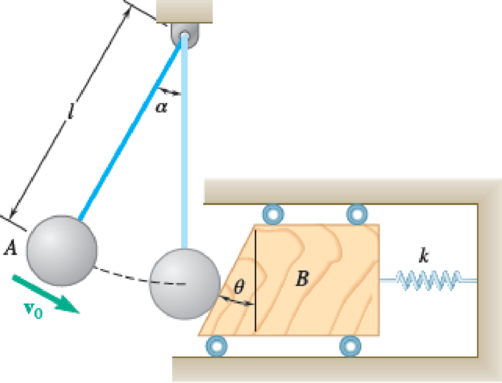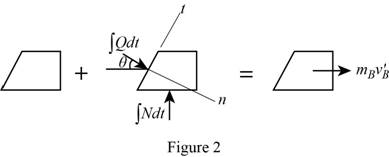
When the rope is at an angle of α = 30°, the 1-lb sphere A has a speed v0 = 4 ft/s. The coefficient of restitution between A and the 2-lb wedge B is 0.7 and the length of rope l = 2.6 ft. The spring constant has a value of 2 lb/in. and θ = 20°. Determine (a) the velocities of A and B immediately after the impact, (b) the maximum deflection of the spring, assuming A does not strike B again before this point.

(a)
Find the velocity of A
Answer to Problem 13.188P
The velocity of A
Explanation of Solution
Given information:
The angle of the rope
The weight of the sphere A
The weight of the wedge B
The speed of the sphere A
The coefficient of restitution between A and wedge (e) is 0.7.
The length of the rope (l) is
The spring constant (k) is
The angle
The acceleration due to gravity (g) is
Calculation:
Calculate the mass of sphere A
Substitute
Calculate the mass of wedge B
Substitute
Calculate the initial altitude of sphere
Substitute
Calculate the initial potential energy of sphere
Substitute
Calculate the initial kinetic energy of sphere
Here,
Substitute
Calculate the altitude of sphere just before impact
Substitute
Calculate the initial potential energy of sphere just before impact
Substitute
Calculate the kinetic energy of sphere just before impact
Here,
Substitute
The expression for the principle of conservation of energy between initial and final stage of sphere as follows:
Substitute
Show the impulse-momentum diagram for sphere as in Figure (1).

The expression for the momentum in tangential direction as follows:
Here,
Substitute
Show the impulse-momentum diagram of wedge as in Figure (2).

The expression for the momentum in x-direction as follows:
Here,
Substitute
Calculate the coefficient of restitution (e) using the formula:
Substitute 0.7 for e,
Find the velocity of sphere B immediately after the impact:
Substitute
Find the normal component of velocity of sphere:
Substitute
Calculate the resultant velocity of sphere A
Substitute
Calculate the angle for
Substitute
Calculate the resultant angle of velocity of sphere A
Substitute 63.77 for
Therefore, the velocity of A
(b)
Find the maximum deflection of the spring assuming A does not strike B again before this point.
Answer to Problem 13.188P
The maximum deflection of the spring
Explanation of Solution
Given information:
The angle of the rope
The weight of the sphere A
The weight of the wedge B
The speed of the sphere A
The coefficient of restitution between A and wedge (e) is 0.7.
The length of the rope (l) is
The spring constant (k) is
The angle
The acceleration due to gravity (g) is
Calculation:
Calculate the kinetic energy of wedge block just before impact
Here,
Substitute
The expression for the potential energy of spring at the end of impact
The expression for the principle of conservation of energy for wedge block as follows:
Here,
Substitute
Substitute
Therefore, the maximum deflection of the spring
Want to see more full solutions like this?
Chapter 13 Solutions
Vector Mechanics for Engineers: Statics and Dynamics
- The 12-1b collar B is at rest, and when it is in the position shown the spring is unstretched. Another 2-1b collar A strikes it so that B slides 4 ft on the smooth rod before momentarily stopping. The coefficient of restitution between A and B is e = 0.4. (Figure 1) Figure k = 20 lb/ft? A B 3 ft Part A Determine the velocity of A just after impact measured to the left. Express your answer to three significant figures and include the appropriate units. Enter positive value if the velocity is directed to the left and negative value if the velocity is directed to the right. (VA)2 = Submit Part B F = Value μA Request Answer μА Determine the average force exerted between A and B during the impact if the impact occurs in 0.004 s. Express your answer to three significant figures and include the appropriate units. Value Units Units ? ?arrow_forwardThe 1-1b ball A is thrown so that when it strikes the 10-1b block B it is traveling horizontally at v = 30 ft/s as shown in (Figure 1). Figure A B 1 of 1 Part A If the coefficient of restitution between A and B is e = 0.6, and the coefficent of kinetic friction between the plane and the block is μ = 0.4, determine the distance block B slides on the plane before stopping. Express your answer in feet to three significant figures. VE ΑΣΦ ↓↑ vec S = Submit Previous Answers Request Answer ? ftarrow_forwardEach of the sliders A and B has a mass of 3.0 kg and moves with negligible friction in its respective guide, with y being in the vertical direction. A 29-N horizontal force is applied to the midpoint of the connecting link of negligible mass, and the assembly is released from rest with e = 0. Calculate the speed v with which A strikes the horizontal guide when e = 90°. 0.41 m 29 N 0.41 m B Answer: v = i m/sarrow_forward
- The 3.0-kg collar is released from rest at A and slides down the inclined fixed rod in the vertical plane. The coefficient of kinetic friction is 0.38. Calculate (a) the velocity v of the collar as it strikes the spring and (b) the maximum deflection x of the spring. 3.0 kg H=0.38 Answers: (a) V = A (b) x = 56° HI 0.45 m k = 3.7 kN/m m/s mmarrow_forwardA ball has a weight of 3-lb strikes a 5-lb rod at a point C which far away from A with a value of x = 3 ft. The velocity of the ball mass center (Vog)1 = 6 ft/s when it strikes the rod which is at rest. Assuming the 4 ft coefficient of restitution after the impact e=0.8, determine the following: O After the impact, the velocity of the ball mass center (vop)2- O After the impact, the velocity of point C (vc)2. 0.5 ft o The angular velocity (w) of the rod about the Zaxis. In your calculation, neglect the inertia of the vertical part of the rod AO. r = 0.5 ftarrow_forwardThe system is at rest with the spring unstretched when 8 = 0. The 4 kg particle is then given a slight nudge to the right. (@) If the system comes to momentary rest at e = 36", determine the spring constant k. (b) For the value k=110 N/m, find the total energy and speed of the particle when 8 = 20°. Neglect friction. h= 0.4 marrow_forward
- The 9.0 kg sphere A is held at an angle of 60° as shown, and then is released from rest and hits the B sphere which has a mass of 4.5 kg. In this crash the coefficient of restitution is e = 0.75. The sphere B is attached to the end of a rod lightweight rotating around the O point. The spring is initially non elongated and it is known that the maximum angle θ that the rod turned after the crash measured from the initial position was of 21.4º. Calculate: a) The speed with which sphere A impacts with sphere B. b) The magnitude and direction of the velocities of each sphere A and B after impact. c) The mechanical energy dissipated on impact. d) The spring stiffness constant k.arrow_forward3) When the rope is at an angle of a= 30° the 1-1b sphere A has a speed vo= 4 ft/s. The coefficient of restitution between A and the 2-1b wedge B is 0.7 and the length of the rope /= 2.6 ft. The spring constant has a value of 2 lb/in and 0= 20°. Determine: a) Velocities of A and B immediately after impact b) Maximum deflection of the spring assuming A doesn't strike B again. a Barrow_forwardThe 2.8-kg collar is released from rest at A and slides down the inclined fixed rod in the vertical plane. The coefficient of kinetic friction is 0.62. Calculate (a) the velocity v of the collar as it strikes the spring and (b) the maximum deflection x of the spring. 2.8 kg 0.68 m H=0.62 59 Answers: (a) v = (b) x = i i k = 3.4 kN/m m/s mmarrow_forward
- The small collar of mass m = 0.64 kg is released from rest at A and slides down the curved rod in the vertical plane with negligible friction. Find the velocity v of the collar as it strikes the base at B. Set b = 0.45 m, h = 2.87 m. vB = _________m/sarrow_forwardDisc X has a mass of 25 slugs and is traveling with a velocity of Vx= 39 ft/s as shown. Meanwhile, Disc Y has a mass of 12 slugs and is traveling with a velocity of Vy = 27 ft/s. If the coefficient of restitution between the two discs is e= 0.76, calculate their speeds immediately after the impact. Kindly include the diagram with step-by-step solution with some explanations. Y X 3arrow_forwardEach of the sliders A and B has a mass of 1.8 kg and moves with negligible friction in its respective guide, with y being in the vertical direction. A 11-N horizontal force is applied to the midpoint of the connecting link of negligible mass, and the assembly is released from rest with e = 0. Calculate the speed v with which A strikes the horizontal guide when e = 90°. 0.18 me 11 N 0.18 m, X-arrow_forward
 Elements Of ElectromagneticsMechanical EngineeringISBN:9780190698614Author:Sadiku, Matthew N. O.Publisher:Oxford University Press
Elements Of ElectromagneticsMechanical EngineeringISBN:9780190698614Author:Sadiku, Matthew N. O.Publisher:Oxford University Press Mechanics of Materials (10th Edition)Mechanical EngineeringISBN:9780134319650Author:Russell C. HibbelerPublisher:PEARSON
Mechanics of Materials (10th Edition)Mechanical EngineeringISBN:9780134319650Author:Russell C. HibbelerPublisher:PEARSON Thermodynamics: An Engineering ApproachMechanical EngineeringISBN:9781259822674Author:Yunus A. Cengel Dr., Michael A. BolesPublisher:McGraw-Hill Education
Thermodynamics: An Engineering ApproachMechanical EngineeringISBN:9781259822674Author:Yunus A. Cengel Dr., Michael A. BolesPublisher:McGraw-Hill Education Control Systems EngineeringMechanical EngineeringISBN:9781118170519Author:Norman S. NisePublisher:WILEY
Control Systems EngineeringMechanical EngineeringISBN:9781118170519Author:Norman S. NisePublisher:WILEY Mechanics of Materials (MindTap Course List)Mechanical EngineeringISBN:9781337093347Author:Barry J. Goodno, James M. GerePublisher:Cengage Learning
Mechanics of Materials (MindTap Course List)Mechanical EngineeringISBN:9781337093347Author:Barry J. Goodno, James M. GerePublisher:Cengage Learning Engineering Mechanics: StaticsMechanical EngineeringISBN:9781118807330Author:James L. Meriam, L. G. Kraige, J. N. BoltonPublisher:WILEY
Engineering Mechanics: StaticsMechanical EngineeringISBN:9781118807330Author:James L. Meriam, L. G. Kraige, J. N. BoltonPublisher:WILEY





